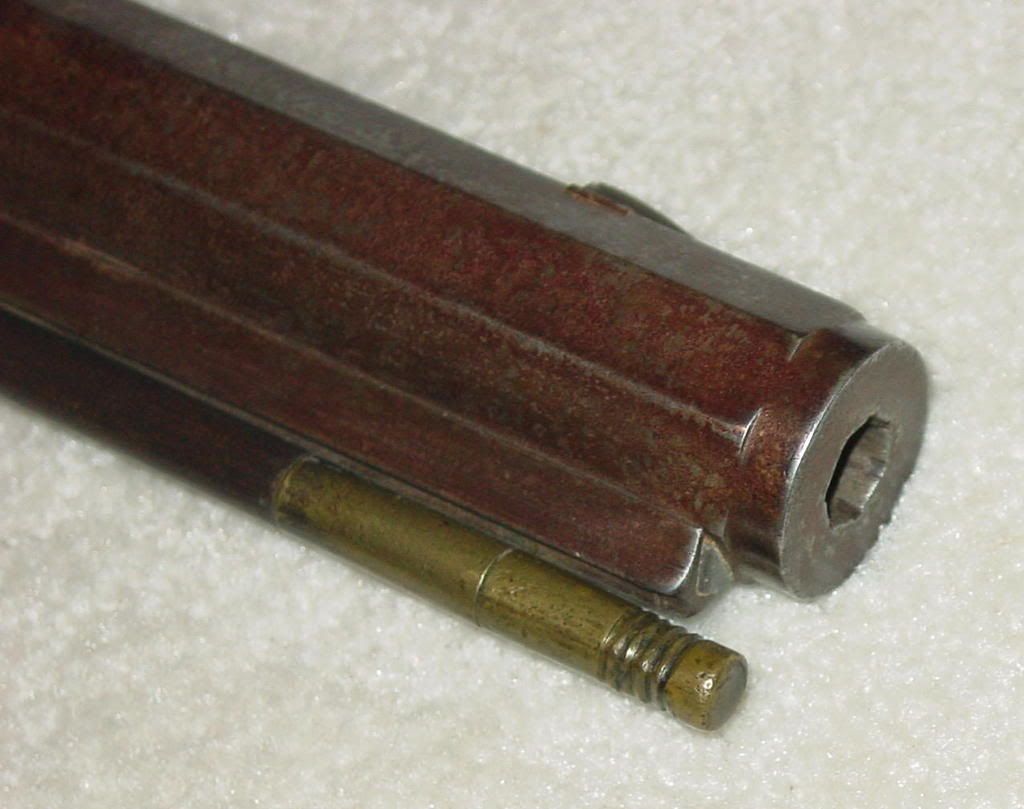This is a walnut halfstock "Plains Rifle" made by Ferdinand G. Fisher, Bellevue, Jackson County, Iowa. Bellevue is right on the Mississippi River, a few miles below Dubuque. Fisher was in Belleview circa 1860 - 1870. He previously worked in Rock Island, Illinois, and later worked in McGregor, Clayton County, Iowa.
Although the weight of this rifle might lead one to think it was intended to be a target rifle, it has only an elevation adjustable hunting sight, and has never had any provision for any type of peep sight. It is exceptionally well made, by a gunsmith who knew how to make even a heavy barreled rifle have pleasing architecture.
Length overall - 51 3/8"
Barrel length - 34 5/8" (including patent breech)
Width across flats - 1 5/16" at breech; 1 3/16" at muzzle
Muzzle is turned for a guide bullet starter (for use with a picket bullet)
Caliber - approximately .46, with 7 groove rifling
Stock - walnut
Mountings - iron
Weight - 14 lbs. 4 oz


















Comments:
Apropos Whisker, a paraphrase "toilet seat", at least commercial patchboxes or cap boxes, do not belong in the Kentucky genre...what is our wisdom? I would take issue in that many rifles, my Benson ( posted), has significant "artistic merit", all be it "folk" and not "golden age". Do we post later period guns....I think yes as they document historical change over time. I suppose this also touches the issue of contemporary and geographic boundaries ( east of the Mississippi).
---------------------------------------------------------------------------------------------------
Nice rifle, great condition, for a gun from "west of the big river." The stock architecture is interesting. In profile I might have thought it was a New York rifle. It has a very short forestock grip area, similar to NY guns. I think the iron mounts add to the gun. Nord's comments raise a question, i.e. what constitutes or defines a "plains" rifle, vs. a target or sporting rifle? If this gun were made in Ohio, Indiana or Kentucky, would it still be called a plains rifle? A good number of later guns had heavier barrels. I think a lot of people look at Hawkins big bore, double keyed, big butted half-stocked rifles to define plains rifles, but how much can a rifle vary from this and still be considered a plains rifle? As Fred and Bruce work to organize, and catalog, the growing number of rifles in the "museum" section, this question may become a significant one.
-----------------------------------------------------------------------------------------------------
In regard to defining what constitutes a "Plains Rifle", perhaps the best source would be Charles E. Hanson, Jr.'s book, "The Plains Rifle", Copyright 1960, published by The Gun Room Press. Hanson was the curator at the Museum of the Fur Trade, in Chadron, Nebraska.
Hanson put it this way:
"No endorsement of the term "Plains Rifle" is intended; the name was used because it is popular with collectors today and because it is a good all-inclusive-type-name. In fur trade days, a first class trapper's rifle was a Hawken, and it was generally referred to as a 'Mountain Rifle'. The field of this book has been broadened to include all rifles which might have been made with the Plainsman in mind."
Hanson goes on to say:
"Basically this rifle should be suitable to carry on a horse, the plainsman's prime locomotor. This would make a maximum barrel length of about 42 inches for the earliest types with the average varying from 28 to 38 inches. The caliber and intended charge should be designed for grizzly bear and buffalo, surely never below .42 caliber and rarely more than .58. The average would be .45 to .55. The barrel would be heavy enough for service charges of 100 grains or better. The stocking would be plain with a minimum of inlays."
A number of the rifles by various makers that are pictured in his book are NOT double-keyed, and this feature alone does not define a Plains Rifle. He does mention that if single-keyed, it must have had a large and sturdy key.
----------------------------------------------------------------------------------------------------
And by-the-way....notice the spelling of "Bellview", Iowa on Fisher's stamp? It is now spelled "Bellevue". Whether the spelling has been changed or Fisher misspelled it, I can't tell you.
----------------------------------------------------------------------------------------------------
I just checked the 1870 census for the spelling. It was "Bellevue" even then, so Fisher must have misspelled it when he made his stamp. Fisher is listed as 51 years old, born in Prussia, in 1870. The 1860 census lists his birthplace as "Holstein".

